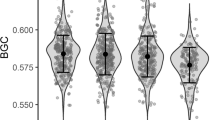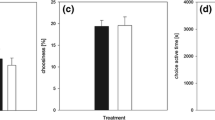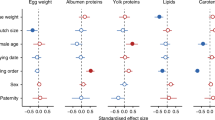Abstract
Transfer of maternal hormones to the eggs is a major source of offspring phenotypic variation. The developmental and organizational effects of egg hormones can extend into adulthood and affect behavioral and morphological traits involved in sexual and reproductive behavior, with important consequences for offspring fitness. In this study, we injected testosterone (T) in egg albumen of captive ring-necked pheasant (Phasianus colchicus) eggs. We then assessed the consequences for chick growth, cell-mediated immunity, and multiple male secondary sexual traits at maturity by comparison with a control group. We also compared the covariation between traits in the two experimental groups. We found that control males had redder wattles than males from T-injected eggs, suggesting that attractiveness and reproductive success of the offspring might vary depending on maternal transfer of T to the eggs. T treatment also modified the covariation between cell-mediated immunity and wattle coloration and between the area of the wattle and the expression of another secondary sexual trait, the ear tufts. These effects are likely to translate into fitness differences among the offspring if mate acquisition depends on the simultaneous expression of several traits that are differentially affected by the same maternal contribution. Maternal effects mediated by egg hormones might affect the fitness of the offspring not only by directional modification of phenotypic traits, but also by facilitating or inhibiting their covariation. This suggests the possibility that female choice based on the relative expression of multiple secondary sexual traits exerts a pressure on how maternal transfer of androgens contributes to developmental programs.

Similar content being viewed by others
References
Adkins-Regan E, Ottinger MA, Park J (1995) Maternal transfer of estradiol to egg yolks alters sexual differentiation of avian offspring. J Exp Zool 271:466–470
Álonso-Alvarez C, Perez-Rodriguez L, Mateo R, Chastel O, Vinuela J (2008) The oxidation handicap hypothesis and the carotenoid allocation trade-off. J Evol Biol 21:1789–1797
Armenta JK, Dunn PO, Whittingham LA (2008) Quantifying avian sexual dichromatism: a comparison of methods. J Exp Biol 211:2423–2430
Arnold AP (2002) Concepts of genetic and hormonal induction of vertebrate sexual differentiation in the twentieth century, with special reference to the brain. In: Pfaff E, Pfaff E et al (eds) Hormones, brain, and behavior, vol 4. Academic, New York, pp 105–135
Badyaev AV (2002) Growing apart: an ontogenetic perspective on the evolution of sexual size dimorphism. Trends Ecol Evol 17:369–378
Baratti M, Ammannati M, Magnelli C, Massolo A, Dessì-Fulgheri F (2010) Are large wattles related to particular MHC genotypes in the male pheasant? Genetica 138:657–665
Benowitz-Fredericks M, Kitaysky A, Meddle S (2006) Effects of elevated yolk steroids on steroid receptor and aromatase mRNA expression in the hatchling quail (Coturnix japonica) brain. In Poster E-bird Conf. Glasgow, November 2006
Berglund A, Bisazza A, Pilastro A (1996) Armaments and ornaments: an evolutionary explanation of traits of dual utility. Biol J Linn Soc 58:385–399
Blas J, Perez-Rodriguez L, Bortolotti GR, Vinuela J, Marchant TA (2006) Testosterone increases bioavailability of carotenoids: insights into the honesty of sexual signalling. Proc Natl Acad Sci U S A 103:18633–18637
Bonisoli-Alquati A, Rubolini D, Romano M, Boncoraglio G, Fasola M, Saino N (2007) Effects of egg albumen removal on yellow-legged gull chick phenotype. Funct Ecol 21:310–316
Bonisoli-Alquati A, Martinelli R, Rubolini D, Saino N (2008) Sex-specific effects of albumen removal and nest environment manipulation on barn swallow nestlings. Ecology 89:2315–2324
Bonisoli-Alquati A, Rubolini D, Romano M, Cucco M, Fasola M, Caprioli M, Saino N (2010) Egg antimicrobials, embryo sex and chick phenotype in the yellow-legged gull. Behav Ecol Sociobiol 64:845–865
Bonisoli-Alquati A, Matteo A, Ambrosini R, Rubolini D, Romano M, Caprioli M, Dessì-Fulgheri F, Baratti M, Saino N (2011) Effects of egg testosterone on female mate choice and male sexual behavior in the pheasant. Horm Behav 59:75–82
Briganti F, Papeschi A, Mugnai T, Dessì-Fulgheri F (1999) Effect of testosterone on male traits and behaviour in juvenile pheasants. Ethol Ecol Evol 11:171–178
Candolin U (2003) The use of multiple cues in mate choice. Biol Rev 78:575–595
Carere C, Balthazart J (2007) Sexual versus individual differentiation: the controversial role of avian maternal hormones. Trends Endocrinol Metab 18:73–80
Costantini D, Møller AP (2008) Carotenoids are minor antioxidants for birds. Funct Ecol 22:367–370
Cramp S (1998) The complete birds of the Western Palearctic on CD-ROM. Oxford University Press, Oxford
Daisley JN, Bromundt V, Möstl E, Kotrschal K (2005) Enhanced yolk testosterone influences behavioral phenotype independent of sex in Japanese quail chicks Coturnix japonica. Horm Behav 47:185–194
Egeland ES, Parker H, Liaaenjensen S (1993) Carotenoids in combs of capercaillie (Tetrao urogallus) fed defined diets. Poult Sci 72:747–751
Eising CM, Eikenaar C, Schwabl H, Groothuis TGG (2001) Maternal androgens in black-headed gull (Larus ridibundus) eggs: consequences for chick development. Proc R Soc Lond B Biol Sci 268:839–846
Eising CM, Müller W, Dijkstra C, Groothuis TGG (2003) Maternal androgens in egg yolks: relation with sex, incubation time and embryonic growth. Gen Comp Endocrinol 32:241–247
Eising CM, Müller W, Groothuis TGG (2006) Avian mothers create different phenotypes by hormone deposition in their eggs. Biol Lett 2:20–22
Elf PK, Fivizzani AJ (2002) Changes in sex steroid levels in yolks of the leghorn chicken, Gallus domesticus, during embryonic development. J Exp Zool 293:594–600
Endler JA (1990) On the measurement and classification of color in studies of animal color patterns. Biol J Linn Soc 41:315–352
Ferrari RP, Martinelli R, Saino N (2006) Differential effects of egg albumen content on barn swallow nestlings in relation to hatch order. J Evol Biol 19:981–993
Fisher RA (1921) On the probable error of a coefficient of correlation deduced from a small sample. Metron 1:3–32
Folstad I, Karter AJ (1992) Parasites, bright males, and the immunocompetence handicap. Am Nat 139:603–622
Gil D (2008) Hormones in avian eggs: physiology, ecology and behavior. In: Brockmann HJ, Roper TJ, Naguib M, Wynne-Edwards KE, Barnard C, Mitani J (eds) Advances in the study of behavior. Elsevier, Amsterdam, pp 337–398
Gilbert L, Bulmer E, Arnold KE, Graves JA (2007) Yolk androgens and embryo sex: maternal effects or confounding factors? Horm Behav 51:231–238
Groothuis TGG, Schwabl H (2008) Hormone-mediated maternal effects in birds: mechanisms matter but what do we know of them? Phil Trans R Soc B 363:1647–1661
Groothuis TGG, Müller W, Engelhardt NV, Carere C, Eising C (2005) Maternal hormones as a tool to adjust offspring phenotype in avian species. Neurosci Biobehav Rev 9:329–352
Hartley RC, Kennedy MW (2004) Are carotenoids a red herring in sexual display? Trends Ecol Evol 19:353–354
Hill DA, Robertson P (1988) The pheasant. Ecology, management and conservation. BSP Professional Books, Oxford
Johnston GIH, Moore MC (2005) Transfer of maternal corticosterone to yolk in preovulatory and postovulatory tree lizard (Urosaurus ornatus) eggs. Integr Comp Biol 45:1021
Kimball RT, Braun EL (2008) A multigene phylogeny of Galliformes supports a single origin of erectile ability in non-feathered facial traits. J Avian Biol 39:438–445
Lochmiller RL, Vestey MR, Boren JC (1993) Relationship between protein nutritional-status and immunocompetence in northern bobwhite chicks. Auk 110:503–510
Mateos C (1998) Sexual selection in the ring-necked pheasant: a review. Ethol Ecol Evol 10:313–332
Mateos C, Carranza J (1995) Female choice for morphological features of male ring-necked pheasants. Anim Behav 49:737–748
Mateos C, Carranza J (1996) On the intersexual selection for spurs in the ring-necked pheasant. Behav Ecol 7:362–369
Mateos C, Carranza J (1997) Signals in intra-sexual competition between ring-necked pheasant males. Anim Behav 53:471–485
McGraw KJ (2006) Sex steroid dependence of carotenoid-based colouration in female zebra finches. Physiol Behav 88:347–352
Møller AP, Pomiankowski A (1993) Why have birds got multiple sexual ornaments? Behav Ecol Sociobiol 32:167–176
Mougeot F (2008) Ornamental comb colour predicts T-cell-mediated immunity in male red grouse Lagopus lagopus scoticus. Naturwissenschaften 95:125–132
Mougeot F, Martínez-Padilla J, Pérez-Rodríguez L, Bortolotti GR (2007a) Carotenoid-based coloration and ultraviolet reflectance of the sexual ornaments of grouse. Behav Ecol Sociobiol 61:741–751
Mougeot F, Pérez-Rodríguez L, Martínez-Padilla J, Leckie F, Redpath FM (2007b) Parasites, testosterone and honest carotenoid-based signalling of health. Funct Ecol 21:886–898
Mougeot F, Martínez-Padilla J, Webster LMI, Blount JD, Pérez-Rodríguez L, Piertney SB (2009) Honest sexual signalling mediated by parasite and testosterone effects on oxidative balance. Proc R Soc Lond B Biol Sci 276:1093–1100
Müller W, Eens M (2009) Elevated yolk androgen levels and the expression of multiple sexually selected male characters. Horm Behav 55:175–181
Müller W, Deptuch K, López-Rull I, Gil D (2007) Elevated yolk androgen levels benefit offspring development in a between clutch context. Behav Ecol 18:929–936
Navara KJ, Hill GE, Mendonça MT (2005) Variable effects of yolk androgens on the growth and immunity in bluebird nestlings. Physiol Biochem Zool 78:570–578
Ödeen A, Håstad O (2006) Complex distribution of avian color vision systems revealed by sequencing the SWS1 opsin from total DNA. Mol Biol Evol 20:855–861
Ohlsson T, Smith HG, Råberg L, Hasselquist D (2003) Effects of nutrition on sexual ornaments and humoral immune responsiveness in adult male pheasants. Ethol Ecol Evol 15:31–42
Owens IPF, Short RV (1995) Hormonal basis of sexual dimorphism in birds: implications for new theories of sexual selection. Trends Ecol Evol 10:44–46
Paitz RT, Bowden RM (2008) A proposed role of the sulfotransferase/sulfatase pathway in modulating yolk steroid effects. Integr Comp Biol 48:419–427
Palmer BD, Guillette LJ Jr (1991) Oviductal proteins and their influence on embryonic development in birds and reptiles. In: Ferguson MWJ, Deeming DC (eds) Egg incubation: its effects on embryonic development in birds and reptiles. Cambridge University Press, Cambridge, pp 29–46
Papeschi A, Briganti F, Dessì-Fulgheri F (2000) Winter androgen levels and wattle size in male common pheasants. Condor 102:193–197
Papeschi A, Carroll JP, Dessì-Fulgheri F (2003) Wattle size is correlated with male territorial rank in juvenile ring-necked pheasants. Condor 105:362–366
Partecke J, Schwabl H (2008) Organizational effects of maternal testosterone on reproductive behavior of adult house sparrows. Dev Neurobiol 68:1538–1548
Pike N (2011) Using false discovery rates for multiple comparisons in ecology and evolution. Methods Ecol Evol (in press)
Qvarnström A, Price T (2001) Maternal effects, paternal effects, and sexual selection. Trends Ecol Evol 16:95–100
Ridley MW, Hill DA (1987) Social organization in the pheasant (Phasianus colchicus): harem formation, mate selection and the role of mate guarding. J Zool 211:619–630
Rubolini D, Romano M, Martinelli R, Leoni B, Saino N (2006) Effects of prenatal yolk androgens on armaments and ornaments of the ring-necked pheasant. Behav Ecol Sociobiol 59:549–560
Rubolini D, Martinelli R, von Engelhardt N, Romano M, Groothuis TGG, Fasola M, Saino N (2007) Consequences of prenatal androgen exposure for the reproductive performance of female pheasants (Phasianus colchicus). Proc R Soc B Biol Sci 274:137–142
Ruuskanen S, Laaksonen T (2010) Yolk hormones have sex-specific long-term effects on behavior in the pied flycatcher (Ficedula hypoleuca). Horm Behav 57:119–127
Schwabl H (1996) Maternal testosterone in the avian egg enhances postnatal growth. Comp Biochem Physiol 114A:271–276
Sokal RR, Rohlf FJ (1995) Biometry, 3rd edn. Freeman, San Francisco
Stettenheim PR (2000) The integumentary morphology of modern birds—an overview. Am Zool 40:461–477
Storey JD (2002) A direct approach to false discovery rate. J R Stat Soc B 64:479–498
Storey JD, Tibshirani R (2003) Statistical significance for genomewide studies. Proc Natl Acad Sci U S A 100:9440–9445
Storey JD, Taylor JE, Siegmund D (2004) Strong control, conservative point estimation, and simultaneous conservative consistency of false discovery rates: a unified approach. J Roy Stat Soc B 66:187–205
Strasser R, Schwabl H (2004) Yolk testosterone organizes behavior and male plumage coloration in house sparrows (Passer domesticus). Behav Ecol Sociobiol 56:491–497
Uller T, Eklöf J, Andersson S (2005) Female egg investment in relation to male sexual traits and the potential for transgenerational effects in sexual selection. Behav Ecol Sociobiol 57:584–590.
von Engelhardt N, Carere C, Dijkstra C, Groothuis TGG (2006) Sex-specific effects of yolk testosterone on survival, begging and growth of zebra finches. Proc R Soc Lond B Biol Sci 273:65–70
von Schantz T, Göransson G, Andersson G, Fröberg I, Grahn M, Helgée A, Wittzell H (1989) Female choice selects for a viability-based trait in pheasants. Nature 337:166–169
von Schantz T, Bensch S, Grahn M, Hasselquist D, Wittzell H (1999) Good genes, oxidative stress and condition-dependent sexual signals. Proc R Soc Lond B Biol Sci 266:1–12
Zuk M, Thornhill R, Ligon JD, Johnson K, Austad S, Ligon SH, Thornhill NW, Costin C (1990) The role of male ornaments and courtship behavior in female mate choice of red jungle fowl. Am Nat 136:459–473
Acknowledgments
We are sincerely grateful to G.P. Oldani for the helpful technical support and suggestions. We thank R. Martinelli, A. Cavalleri, and E. Venturelli for their precious help during hormone assays. A. Matteo, B. Leoni, U. Oldani, P. Usorini, S. Bocchi, and A.T. Gerevini greatly helped during data collection, and A. Binelli provided useful comments on a previous draft of the paper. All experiments were conducted in compliance with the Italian norms for farming practice. ABA was funded by a PhD grant from the Italian Ministry of Education (MIUR).
Author information
Authors and Affiliations
Corresponding author
Additional information
Communicated by C. Brown
Rights and permissions
About this article
Cite this article
Bonisoli-Alquati, A., Rubolini, D., Caprioli, M. et al. Egg testosterone affects wattle color and trait covariation in the ring-necked pheasant. Behav Ecol Sociobiol 65, 1779–1790 (2011). https://doi.org/10.1007/s00265-011-1186-2
Received:
Revised:
Accepted:
Published:
Issue Date:
DOI: https://doi.org/10.1007/s00265-011-1186-2




